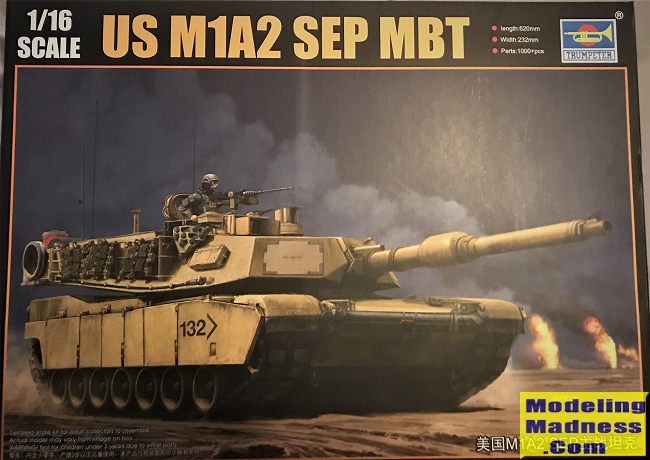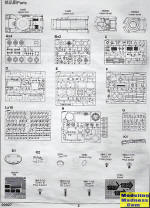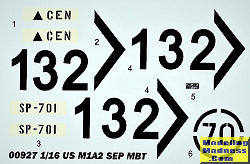
Trumpeter 1/16 M1A2 SEP Abrams
| KIT #: | 00927 |
| PRICE: | $200.00 |
| DECALS: | Two options |
| REVIEWER: | Donald Zhou |
| NOTES: | Advantages: Good details, large scale size, plenty of multimedia parts. Disadvantages: Details all over the place and wrong, many parts simplified, pesky multiple track parts, drive sprocket maybe undersized |

| HISTORY |
The M1 series of tanks was developed in the 70’s as a replacement for the venerable M60. Previously, in a joint program with then West Germany, the U.S. produced the MBT-70 in the ‘60’s as a replacement. That never worked. The then new 155mm short barreled cannon, which can fire the Shillelagh missile was prone to break down and jamming. The rest of the vehicle didn’t fare better either and both nations eventually backed out. The Germans went on to produce their own very successful Leopard II MBT while the U.S. went on to eventually produce the M1.
The first prototype was produced in 1976. The winner was Chrysler. The Germans, who were adamant on selling the Leopard to the U.S. was deemed too expensive while the GM design was deemed too inferior. The tank was the XM1. After Chrysler was bought out by General Dynamics, the design was further improved. It had the same 105mm Royal Ordnance cannon found on the M60, which is upgradable to the 120mm Rhinemetal smoothbore found on the Leopard II. It also had massive improvement to the armor with the British Chobham ceramic armor plates that’s a whole generation ahead of the rolled homogeneous armor found in the M60. The biggest improvement however, was the fire control system. Previous tanks all used analogue sights with daylight vision systems. The M1 replaced them with digital fire control computers with laser range finders that was several jumps ahead along with a Forward Looking Inferred sensors that allowed the tank to fight at night or bad weather. Efficiency were greatly improved although older more experienced crews’ improvement was only incremental. However, the improvements among new raw crews was three or even four times better than older tanks, meaning they can be brought up to standard far quicker. The tank entered service in 1980 and quickly started to prove themselves. Over 3300 M1 were produced. The tanks can run up to 45MPH although there are reports of crews who disabled their governors on the tanks and went up to 55MPH and even beyond! The tank also features an AGT-1500 turbine engine. The engine is quiet, so quiet in fact, the tank gained a nickname of whispering death and can use any sort of fuel, everything from diesel, to straight gasoline and in a pinch, raw alcohol can be burned (although as might surmised, using raw alcohol will wreck the engine’s life). In service, the tank just uses diesel to save logistics nightmares. However, the big disadvantage is the turbine is a huge fuel hog and draws as much as a gallon of fuel for every mile and its infer-red signature is also quite high.
The next major upgrades is the M1A1 version. The biggest difference is the main armament. The Rhinemetal 120mm smoothbore replaced the British 105mm rifled cannon. This meant ammo capacity was dropped from 53 to 42. The other was the armor. Especially the HA (Heavy Armor) and HC (Heavy armor Common) variants, which contained a layer of depleted Uranium to further harden and upgrade the armor. Other improvements includes better bustle racks and a hole was opened just in front of the loader. This hole will prove critical for the next series of upgrade then in development. Over 6000 M1A1’s were produced, many of them are now or have been upgraded under the AIM or Abrams Improvement Management program.
The tank, now named Abrams after late Gen. Creighton Abrams, baptism of fire came in the Middle East. When Iraq and Sadadum Insane invaded Kuwait, U.S. and her allies quickly formed a line of defense to defend Saudi Arabia. Critical among the pieces were Abrams. In fact, over 1800 of the tanks were sent to the Gulf, many of them the latest HA variants to deal with the T-72’s. Before the battle, questions about the tank’s price and effectiveness abound but all of that was settled quickly when the tank proved itself in battle.
In fact, the Abrams totally outclassed its opponents. It can hit its targets as far away as 2KM away and its rangefinders and FLIR worked well in both daylight and night, especially when smoke fire engulfed the region. In fact, one anecdote from the war shows just how near invulnerable the tank was. During a drive, one Abram got stuck in mud. The rest of the unit passed it by since they were under orders to keep moving. While waiting for a tow, three Iraqi T-72’s attacked. The first one fired a HEAT shell and did nothing to the tank. The M1 responded by firing an armor piercing shell that nearly blew the turret off! The second one, not heeding the lesson, also fired a HEAT shell that only made the tank angrier. A second round turned this tank into a funeral pyre. The third tank, finally heeding the warning, fired an armor piercing round that left a grove in the Abrams frontal glacis plate but did not penetrate. Seeing further fighting was redundant, it hid behind a sand berm, thinking it was safe. However, through its FLIR unit, the Abrams tracked the last Iraqi tank and saw the heat plume from its exhaust and put the round where the turret was. The armor piercing round slammed through the sand berm and still penetrated the tank on the other side.
By this time, further Abrams had arrived but still no tow truck…Orders came from above to destroy the stricken tank in place. Since the rest of the Abrams crews did not have high explosives, they decided to use their main cannons for the job.
However, two rounds against the front armor proved to be useless, a tank came up against the side and fired one through the ammo storage bin and finally penetrated. All that did was to set off the blast off panel on top of the turret, which vent the explosive force upwards. After the fire died down, the tank proved to be as tough as ever! While discussing on what to do, the tow finally arrived and with three M88 recovery vehicles, the stricken M1 was finally dragged out of the mud!
There were some hard lessons too though. The least of which, like the M2 Bradley, it turned out, the biggest enemy wasn’t the enemy…it was friendly fire. Of the 9 Abrams destroyed in the war, 7 was from friendlies. At least two was from an errand AH-64 Apache strike with one total loss
After the war, further improvements were added. The biggest was the M1A2 version. The hole on top of the tank was replaced by a CIV or Commander Independent thermal Viewer. This allowed the tank to finally conduct “Search while hunt” at the same time. Electronics were further improved to allow one A2 to talk to another or any similarly equipped tank. Furthermore, to guard against the painful lesson of friendly fire, “cold” identification panels were added to the front of the turret, the side and rear. The A2 was also improved with the SEP or System Expansion Program and the SEP2, which added FBCB2 and other improvement to the armor etc.
By the time the second Gulf War rolled around, the Abrams that participated in this war only look like the same Abrams that participated in the first one. The insides though, were completely different and generations ahead. After the war, however, the Abrams faced its toughest test yet, fighting in urban terrain.
The fact of the matter is, tanks are not suited in urban terrain. They are too big, too unwieldy in a city and there are a lot of spots for insurgents to take pot shots at it. The press were quick to point out the Russian disaster that was Chechenia and Grozny. Insurgents quickly found out going toe to toe with an Abrams was tantamount to suicide. However, taking pot shot at it from the rear or firing an RPG from the rooftop at the tank’s roof is a far better option. Either that, or load up an IED and then blow up its soft underbelly!
To combat this, the Tank Urban Survival Kit upgrade was developed. This is a field upgradable kit that radically improve the tank’s survival in an urban terrain. The first thing added was something from WW II, an infantry to tank talkie phone on the back. The next one was a “V” shaped armor piece that was added to the belly to not only add armor strength against IED’s, but also to blunt and deflect the blast away from the tank. The third is a series of armor glass panes were added to both the commander and the loader’s weapon stations so they can operate their weapons out of the tank without worrying about snipers. Finally, to guard against the tank’s sides, a series of ERA armor panels were added to the tank’s side skirts.
When introduced, the kit quickly proved popular and well suited in an urban terrain. However, further improvements were added from combat reports. These became the TUSK II kit. These includes: further slate armors were added to the rear engine grill. A second .50 cal machine gun was added to the top of the main cannon and a series of ceramic tile ERA armor pieces were added to the turret sides and onto the existing side skirt ERA armor.
With these improvements, the tank soon proved to be a hard nut to crack. There is a M1A3 version. However, due to budget cuts, that version is in limbo so the Army and Marines will have to do with the current version for the foreseeable future.
| THE KIT |
 Ok, this is the end, I hope, for my Abrams-titis. But yes, I have been
keeping an eye out for this kit since Trumpeter announced it. I promised myself
I’ll only get two 1/16 scale tank kits. The first one I already gotten and made
and reviewed, which is of course, Trumpeter’s excellent 1/16 King Tiger
(problems notwithstanding, that tank had already drew more than one eyeballs.
Especially since I bought it to IPMS annual model show). This is the second and
last one. Everyone tried to badger me to get Trumpeter’s 1/16 Jadgtiger (which
is heavily based on the King Tiger) and the Panzerkampwagen IV, which are all
excellent….But even for me, I’ll ran out of space with this much big tanks
around! So the second one will always be the M1 Abrams. During Christmas, when a
shop on Amazon lowered the price to $200 and with my points from my credit card,
I finally bit and bought the kit.
Ok, this is the end, I hope, for my Abrams-titis. But yes, I have been
keeping an eye out for this kit since Trumpeter announced it. I promised myself
I’ll only get two 1/16 scale tank kits. The first one I already gotten and made
and reviewed, which is of course, Trumpeter’s excellent 1/16 King Tiger
(problems notwithstanding, that tank had already drew more than one eyeballs.
Especially since I bought it to IPMS annual model show). This is the second and
last one. Everyone tried to badger me to get Trumpeter’s 1/16 Jadgtiger (which
is heavily based on the King Tiger) and the Panzerkampwagen IV, which are all
excellent….But even for me, I’ll ran out of space with this much big tanks
around! So the second one will always be the M1 Abrams. During Christmas, when a
shop on Amazon lowered the price to $200 and with my points from my credit card,
I finally bit and bought the kit.
Damn that’s another big box! Damn, not another kit with over 1000 parts! The big box are divided into three boxes inside. The large one contains all the parts and sprues for the tank itself. The second smaller one contain the upper and lower hull, with the molded on side skirts and the upper and lower turret. The small, thin box contains the plastic wheel rims, the turret ring, and photo-etch and clear parts.
Judging the sprues, I quickly realized that at least 600 parts are the tracks…Yes, they are multiple assembly, moving pieces. Five pieces are needed per track. A two central links are needed in which two track shoes are placed in the center of the two links. Gluing the right place will ensure the track move afterward. Then the guide tooth is placed in the middle……Each side requires 78 links so yeah…Better be prepared for the long haul.
The rest of the kit is straightforward. However, you can already tell what with the tracks taking up most of the parts, the rest of the kit is very simplified. The detail is still generally good but nowhere near where the kit should be for such a big scale. The anti-slip coating is nice, clear parts are provided for the relevant parts and all are accounted for but if you know where to look, you can quickly see where all the corners that were cut and simplified. For example, the hubcaps should be clear since it allows the crew to tell how much lubricants are still in the torsion arms and the wheels. This does not matter since the caps will be heavily weathered anyways. Some are just unforgivable. The gun barrel are still in two pieces when slide-mold technology should’ve allowed one single hollow tube. The commander hatch is molded right onto the hole itself…Preventing the open option. This is highly disappointing for me cause I like to get one or two figures to show off the tank’s scale and give it a little personality. Otherwise, details are generally good and everything that should be there is there.
But again, in commonality with the M1A1 kit, several parts of the kit are
more inline with the A1, rather than the A2, or even the SEP. The telltale are
the “X”’s on the fenders. M1A2 does not have them. Both the Driver hatch and the
“doghouse” gunner sight are from the A1. The A2, both units are smooth and
completely square. The rear of the hull, the right most rear end, the fuel cap
there is gone for the A2. The fuel tank here was removed since the M1A1 HAC and
an internal auxiliary power pack was installed instead. This means the fuel cap
is gone. The most egregious though, is the NBC or Nuclear, Biological, Chemical
air intake. This is on the left side of the tank only. Yet, on this kit, it’s on
both the right and left!!! This means you need to break out the dremel and sand
away the details on the right. The most disappointing missing parts are the CIP
or Combat Identification “cold” panels. After the first Gulf War, in order to
prevent friendly-fire, or at least reduce them, “cold” identification panels
were installed on all U.S. and sometimes ally vehicles. The front turret face
usually features two thin solid square panels. The sides and rear feature one
venetian blind link panels each. These are all missing from the kit and is a
serious goof since the kit is announced as a M1A2 SEP and all SEP tanks, and all
tanks, whether M1A1 or M1A2 all have the CIP during the 2003 Gulf War II!
Finally, reports also describe the drive sprockets as being too small. But
that’s relevant for the M1A1. Whether Trumpeter corrected this problem or not
remains to be seen. If not, the AFV Club does make a set of resin corrected
sprocket set.
two thin solid square panels. The sides and rear feature one
venetian blind link panels each. These are all missing from the kit and is a
serious goof since the kit is announced as a M1A2 SEP and all SEP tanks, and all
tanks, whether M1A1 or M1A2 all have the CIP during the 2003 Gulf War II!
Finally, reports also describe the drive sprockets as being too small. But
that’s relevant for the M1A1. Whether Trumpeter corrected this problem or not
remains to be seen. If not, the AFV Club does make a set of resin corrected
sprocket set.
As for me, scratch building some of these are easy enough, especially the front CIP but I’m lazye so got the 1/16 detail sets from eBay which are for a radio controlled M1 tank instead that has all three venetian blind style CIP for the side and rear and will scratch build the front ones.
| CONCLUSIONS |
So in the end, this kit has problems. As it turned out, it’s heavily based on Trumpeter’s own 1/16 scale radio controlled M1 (Henglong I believe) with upgraded details and extra detail set. But still, this kit is $200 and if you can find one on sale, will be cheaper. Now, Tamiya also now makes a 1/16 M1 that is supposedly much much sharper and much more details but at a retail price of $650, it is out of reach of most people, including me so this will do. In the end, with my update set and some dremeling and scratch building, I should have my 1/16 scale M1. As for the missing or wrong detail, only an Abrams tanker will probably know whether it is wrong or not. Layman will never notice. In the end, maybe that’s all that matters
January 2019
Copyright ModelingMadness.com
If you would like your product reviewed fairly and fairly quickly, please contact the editor or see other details in the Note to Contributors.
Back to the Main Page Back to the Review Index Page Back to the Previews Index Page